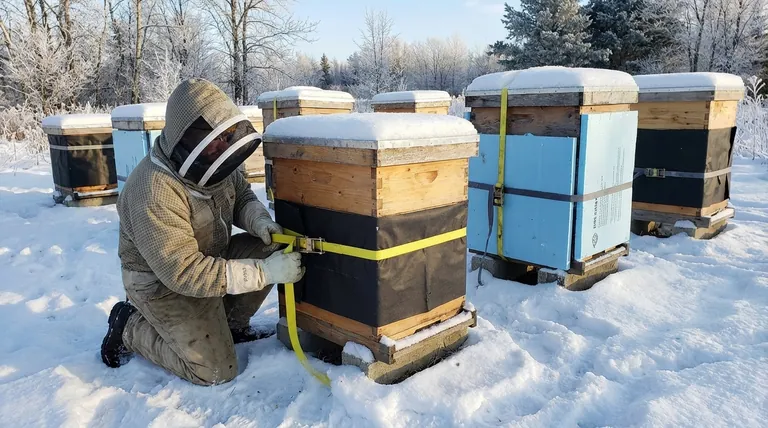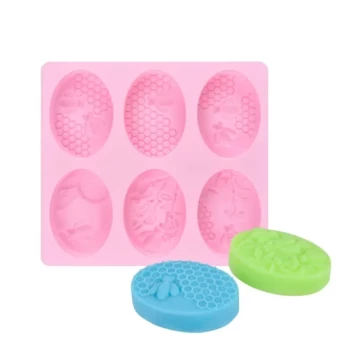Insulating a beehive for winter is about creating a stable environment, not just adding warmth. The most common methods involve using hive wraps made of black plastic or tar paper to block wind and absorb solar heat, adding rigid foam insulation boards around the hive bodies, and ensuring the top of the hive is insulated to prevent heat loss and manage moisture. These actions help the bee cluster regulate its temperature more efficiently without expending excess energy.
The primary goal of winterizing a hive is not just to keep bees warm, but to create a dry, draft-free environment with accessible food. Effective insulation works in tandem with proper ventilation and moisture control to prevent the two biggest winter threats: condensation and starvation.

The Core Principles of Winter Hive Management
Before applying any insulation, it's critical to understand what you're trying to achieve. Bees do not heat the entire hive; they form a tight cluster and generate heat at its center. Your job is to support this natural process.
Temperature Regulation, Not Just Heat
Honeybees are experts at thermoregulation. The insulation you add doesn't "heat" the hive; it simply reduces the rate at which the heat generated by the bee cluster escapes.
This allows the colony to consume less honey to stay warm, conserving their vital winter food stores.
The Critical Role of Ventilation
As bees consume honey and breathe, they release a significant amount of warm, moist air. If this moisture-laden air hits a cold inner cover, it will condense and drip back down onto the bees.
Wet bees are dead bees. Proper winterizing requires an upper entrance or ventilation port. This allows the warm, moist air to escape, keeping the cluster dry even in the coldest weather.
Ensuring Access to Food Stores
A colony can starve to death even with honey in the hive. During deep cold, the cluster is hesitant or unable to move across cold, empty frames to reach food on the other side.
Before winter, beekeepers should organize the frames to ensure the honey stores are consolidated together, creating a contiguous food source that the cluster can easily access as it moves through the hive.
Pest and Draft Protection
Winter brings threats from mice seeking a warm home and from cold drafts that stress the colony.
An entrance reducer shrinks the main opening, making it easier for the bees to defend. A mouse guard (hardware cloth with bee-sized holes) is often placed over this reduced entrance to prevent rodents from getting inside.
Practical Insulation Methods
Based on the core principles, you can choose from several effective insulation techniques.
Hive Wraps
The most common method is wrapping the hive bodies with a material like black plastic or tar paper.
This serves two purposes: it acts as a windbreak to stop drafts, and the black color absorbs solar radiation on sunny days, adding a small amount of passive heat to the hive walls. Any wrap must include an upper entrance for ventilation.
Rigid Foam Insulation
Cutting rigid foam insulation boards to fit the sides of the hive is another excellent option.
These boards provide a higher R-value (insulation rating) than simple wraps. They can be secured with straps and reused for many seasons. It's crucial not to block any hive entrances when installing them.
Top Insulation and Moisture Control
Since most heat is lost through the top of the hive, this is a critical area to address.
Placing a piece of rigid foam insulation directly on top of the inner cover (but under the telescoping outer cover) significantly reduces heat loss. Some beekeepers use a "quilt box," a shallow box filled with wood shavings, which both insulates and absorbs excess moisture.
Understanding the Trade-offs and Pitfalls
Insulating improperly can do more harm than good. Awareness of common mistakes is essential for success.
Over-insulating without Ventilation
The single biggest mistake is to seal up a hive too tightly. Without an escape route for moist air, insulation will trap condensation inside the hive.
This leads to a damp, cold environment that promotes mold and can chill the bee cluster directly, which is often fatal. Ventilation is not optional.
Blocking the Entrance Entirely
While reducing the entrance is vital, blocking it completely is a death sentence. Bees need to be able to leave the hive on warmer winter days for "cleansing flights" to defecate.
A blocked entrance also prevents air exchange, leading to a buildup of carbon dioxide.
Relying Solely on Insulation
Insulation cannot save a weak or starving colony. The health and population of the hive going into winter are paramount.
A strong, disease-free colony with ample food stores is the foundation of winter survival. Insulation is a tool to help a healthy colony thrive, not a cure for underlying problems like Varroa mites or insufficient honey.
Making the Right Choice for Your Colony
Your approach should be based on your climate, resources, and specific colony needs.
- If your primary focus is simplicity and wind protection: A simple black hive wrap is an effective and low-cost solution.
- If your primary focus is preventing moisture buildup: Top insulation combined with a dedicated upper ventilation entrance is the most critical step you can take.
- If your primary focus is maximum thermal efficiency: Combining rigid foam board on the sides with top insulation offers the highest level of protection for very cold climates.
- If your primary focus is overall colony survival: Remember that insulation is just one part of an integrated system that includes Varroa mite management, ensuring massive food stores, and providing proper ventilation.
Ultimately, successful wintering is about creating a stable, dry home that allows your bees to do what they do best: survive.
Summary Table:
| Method | Primary Function | Key Benefit |
|---|---|---|
| Hive Wraps | Blocks wind, absorbs solar heat | Simple, cost-effective windbreak |
| Rigid Foam Insulation | Reduces heat loss from hive bodies | High R-value, reusable for seasons |
| Top Insulation / Quilt Box | Prevents heat loss and manages moisture | Critical for moisture control and warmth |
| Entrance Reducer & Mouse Guard | Protects against drafts and pests | Essential for colony defense and stability |
Ensure your colonies survive and thrive this winter with the right equipment. HONESTBEE supplies commercial apiaries and beekeeping equipment distributors with durable, wholesale-focused winterizing supplies—from hive wraps and insulation boards to entrance reducers. Let us help you prepare. Contact our team today to discuss your needs and secure your seasonal inventory.
Visual Guide

Related Products
- Professional Galvanized Hive Strap with Secure Locking Buckle for Beekeeping
- Heavy-Duty Nylon Beehive Hive Strap with Stainless Steel Cinch Buckle
- Versatile Ratchet Hive Strap with S-Hooks for Secure Fastening
- Jenter Queen Rearing Kit Complete Set for Bee Breeding
- Langstroth Honey Bee Box Hive Boxes for Different Depths
People Also Ask
- What are the two styles of hive straps? Choose the Right Strap for Your Hive Security
- Can straps with hook ends be used for beehives? A Guide to Secure Hive Management
- What are the types of Emlocks available? Choose the Right Strap for Hive Security
- How can beekeepers secure the top cover of a hive? Protect Your Colony from Wind and Weather
- Why are hive straps important for beekeepers? Secure Your Hives Against Wind, Predators & Transport



















